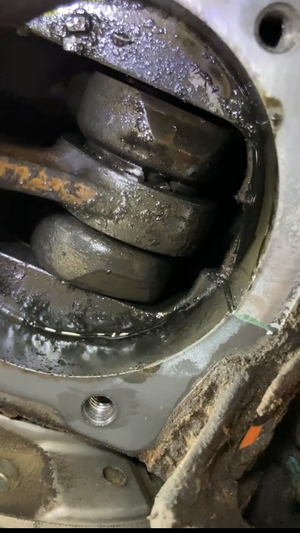This should be true and is to some extent. However, a good quality metal caged bearing, in my experience, usually lasts the life of the rest of the saw or longer. Since early 2016, we have sold a couple dozen Echo CS-600/620 saws to a company that does commercial TSI. Of course, that's hard on saws in a different way from logging, but we never had an engine bearing failure in them (some of the original 2016 saws are still in service). These are metal-caged bearings. They also bought some 550 Husqvarnas in 2019-2020 and most of them had flywheel seal and/or bearing failures at far, far fewer hours. Maybe this has more to do with QC issues on Husqvarna's part than difference between metal and plastic caged bearings, but I definitely put my vote of confidence on metal caged bearings.
44mm piston, lower RPM engine, more heatsink/dissipation mass, standard (non-strato) piston design and 6202 style bearing.
It's not apples to apples comparison.
Also, how many hours were actually on the Echos? Can you provide any proof? Would this conviction hold up under questioning in a court of law?
The 562 is a whole different animal, and 372s have been plagued with bearing failures, using the same spec bearing, with a much heavier piston.
What I am saying is that maybe it's true that the bearings in the CS-590s last longer than in a 562 (which is likely irrefutable) but the bearing failures in a 562 are a result of an AGGREGATE of problems that Husqvarna has attempted to address (with some success) and with each attempt the engineering team has opted to retain usage of the same bearing.
The same bearing is used in the 346s, why aren't we complaining about them and instead, we praise them as maybe a gift from the Gods?
It's not the bearing cage material that is the problem, it is the layers of problems that the 562 has lead to the failure of the bearing. Herein lies what I think the issue really is. The bearing is undersized for the duty that it is applied in. It's a 6202 sized bearing in an application that really should use the next size up. As the rotating mass of the engines has increased as a result of X-Torq technology Husqvarna hasn't modified the bearing size to accommodate for heavier pistons, stuffers, lower crankcase mass and higher rpms held under load.
Maybe we can blame the stubbornness of the engineering team OR the unknown factors on WHY they simply just don't replace the bearing with whatever the guys from OPEForum say. They're missing the silver bullet that we've so subtley placed before them.
"Just change the cage material."
6202s and 6203s regularly fail, Stihl proprietary PTO bearings regularly fail. Our sales history doesn't lie.
But I have to ask myself, with all this talk of plastic cage failure:
"Why would Husqvarna reengineer the 562 with at least 8 updates to rectify bearing failure if it could simply be remedied by adjustment of the bearing cage material?"
Surely, the 5xx series have exhibited bearing failures, over and over again. Everyone knows it. They're junk, but they run so good.
Again, let me reiterate as I have in the past.
If you just need a simple answer to satisfy yourself, then just point to the cage, but I think it's a little more complicated.







